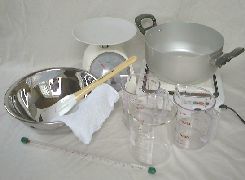

  |
 |
How to make Emulsion GroundsThis page teaches you how to make emulsion grounds on plywoods. The emulsion ground is suitable for Tempera Method , Oil and Tempera Method like Sandro Botticelli , Mixed Media Method and of course regular oil painting. The emulsion paint for grounds is made from Chalk and Titanium White as pigment, Animal skin glue and Sun thickened linseed oil as binder. You can control the ratio of Sun thickened linseed oil to change characteristics of the ground. The Explanation consists of 4 process. The first , paint animal skin glue solution on the surface of the wood board. this process and the layer of glue solution are called "SIZE". The 2nd , cover the board with cloth after drying the size. The 3rd , make emulsion paint. This paint is called "GESSO". And the final , paint the gesso on the board. You will need the following materials and tools.

Pigments ( Chalk , Titanium white )
You may buy Chalk , Titanium White and Shattered rabbit skin glue at the art material shop. About plywoods, I recommend 1.5cm thickness one. Cut them into the size you need. Beakers will be used for heating glue. You should prepare larger and heatproof one(500ml is better). About cloth, this explanation uses cotton cloth, because it's easy to use. But cotton is weak for Acid. If you want your support to have good durability for the erosion caused by acid of drying oil, you should choose a linen. You can get cotton at cloth shops ( new articles may need washing to remove starches). You should ask about linen at the largest art material shop instead of cloth shops. Do size on the board.
In advance , Polish your plywood by fine sandpaper and wipe it by wet cloth. Then make the glue solution ( see How to make glue solution) . And paint the glue solution on your plywood. At first , thin the glue solution by hot water to soak it into fibers of plywoods well. Paint not only the front of the plywood but side and behind , because if you paint only one side, the wood may curve. After the first paint dries( maybe 10 or 20 minutes ), paint 2nd size with glue solution without thinning. To use thumbtacks , you can float your plywoods from the floor until it dries. After drying , Polish it by the finest sandpaper( around 600 ).
Apply cloth on the board.
The reasons of applying cloth are to help connecting between board and paint , to hide grains of wood or connecting line of veniers and etc. And in case of plywood , it's effective to cover the board with thin cloth to avoid comming veniars off. In advance , cut the cloth into the size 10 cm wider each edges( up, down, right and left ) from the size of your plywood. At first paint the plenty of glue solution on the board. Then put the cut cloth on it and spread the cloth from center to edges by your hands or a rubber spatula( like the following pictures ) to let air and extra glue out.
Make the Gesso and paint the Ground.
Now you will make the paint for the ground. There are many recipes. The following table is one of example. The absorbency of your ground can be control by the ratio of drying oil.
At last you will paint the gesso you made just now on the board. Paint not only the front but side and behind. After drying the first paint, paint 2nd layer with different direction of brush. Paint 5 or 6 layer.
It takes a month to dry perfectly. A month later , polish the surface by the finest sandpaper. Author: N.Matsukawa E-Mail: webmaster@cad-red.com Copyright(C)1999-2002 Norihiro Matsukawa, All Rights Reserved. | |||||||||||||||||||||||||||||||||||||||||||||||||||